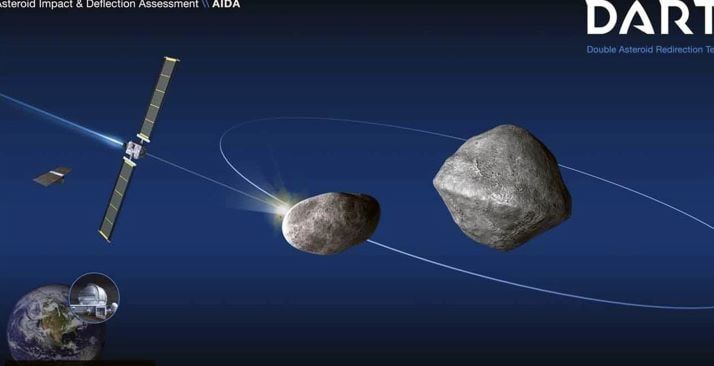Asteroid collision with Earth unlikely in the next 100 years
Although there are objects nearby, at this time, none can cause major damage. The DART Mission is a kinetic impact test that deflects the trajectory of an asteroid but does not destroy it.

In space, there are objects such as comets and asteroids, trapped by the attraction of the Sun or planets, which can pass close to the Earth. They are called NEOs (Near Earth Objects). Some have fallen on our planet, such as the asteroid that produced the Chicxulub crater in Yucatan, 160 kilometers long; the one that fell in Vredefort, South Africa, 300 kilometers long; or the Meteor Crater, 1,200 meters long in the Arizona desert, United States.
However, at present, it is unlikely that an asteroid will collide with our planet in the next 100 years, said Mauricio Reyes Ruiz, a researcher at the Institute of Astronomy (IA) of UNAM in Ensenada, Baja California. "There are objects close, but not in collision orbit with our planet."
At a distance, at a media conference, the astronomer clarified that the atmosphere protects us from a collision, but sometimes it fails to stop the impact and the object comes to collide with our world.
"The asteroid impacts that we observe and many that we don't observe in space, these types of collisions with the Earth are something that happens and will continue to happen. The question is, what do we do? On the one hand, astronomers are dedicated to studying these objects with telescopes, understanding them, knowing what they are made of, how they move, and if their orbit changes. But on the other hand, some countries, in preparation for the possible discovery of an object that will collide with the Earth, have begun to prepare with missions such as DART, "he explained.
According to Joel Humberto Castro Chacón, also an IA researcher in Ensenada, DART is the first attempt to avoid the collision of an object. "It is a test of a technique called kinetic impact, which was conducted by NASA under the name DART, which stands for Double Asteroid Redirect Test."
It's a module that contains a tracker, a camera to search for the object, communication antennas, and solar power arrays. "It's a module of about 1.5 meters, weighing 500 kilograms without the solar panels," he explained.
University scientists considered the NASA mission of September 26 a success since it managed to collide with and modify the trajectory of the Didymos asteroid, 160 meters in diameter.
The organization seeks to test its Planetary Defense Plan, which aims to prevent large asteroid impacts. It will be known in a few days whether the slight deflection achieved was as expected.
Castro Chacón said, "The amount of material that broke off during the impact makes the Didymos-Dimorphos binary asteroid assembly brighter and bigger than it was before."
DART was a low-cost mission, at 230 million dollars, a low budget compared to the 10 billion dollars of the James Webb Space Telescope.
Astronomers from the university said that at the National Astronomical Observatory of San Pedro Mártir in Baja California, they also study NEOs and work on the astronomical project TAOS-II, which involves looking for things beyond Neptune's orbit.
TAOS-II is the Transneptunian Automated Occultation Survey (TAOS-II). It is an international project with Taiwan that will measure the size distribution of small objects (about one kilometer in diameter).
This information includes important data about the formation and dynamical evolution of the solar system and would help to understand the mechanism by which an object in the Kuiper belt is perturbed into a cometary orbit. The project operates three telescopes, every 1.3 meters in diameter, with a field of view of 2.3 square degrees.




